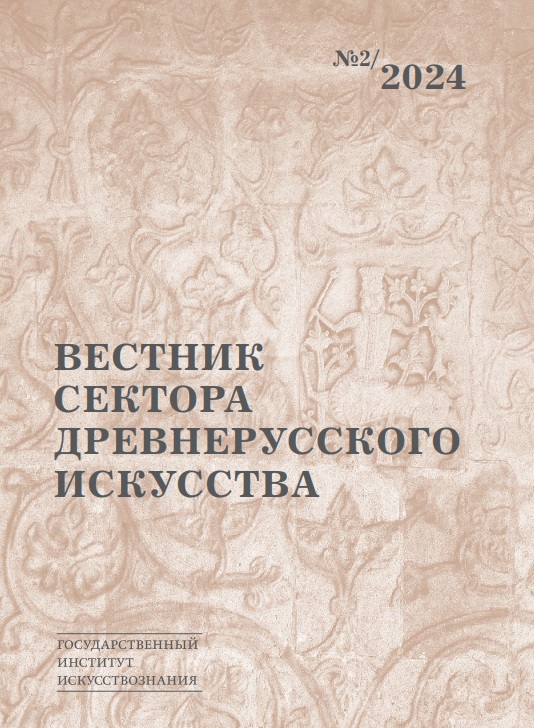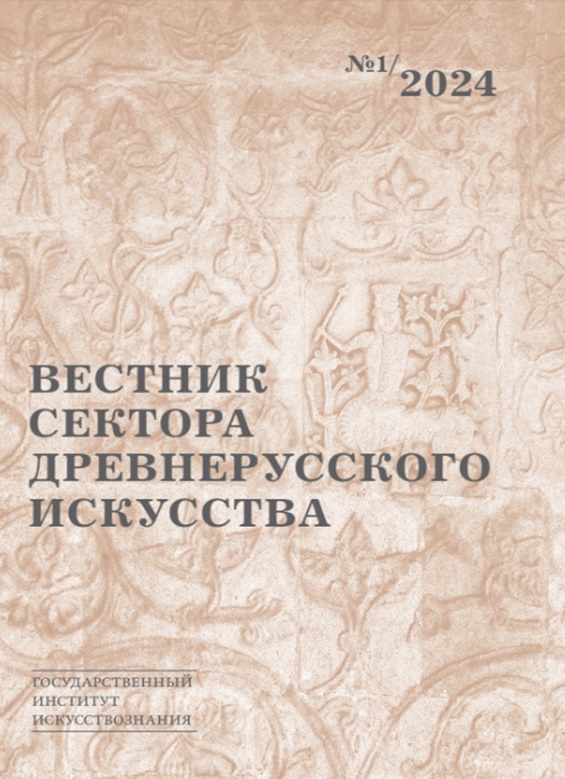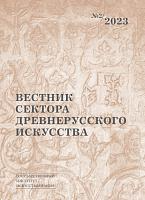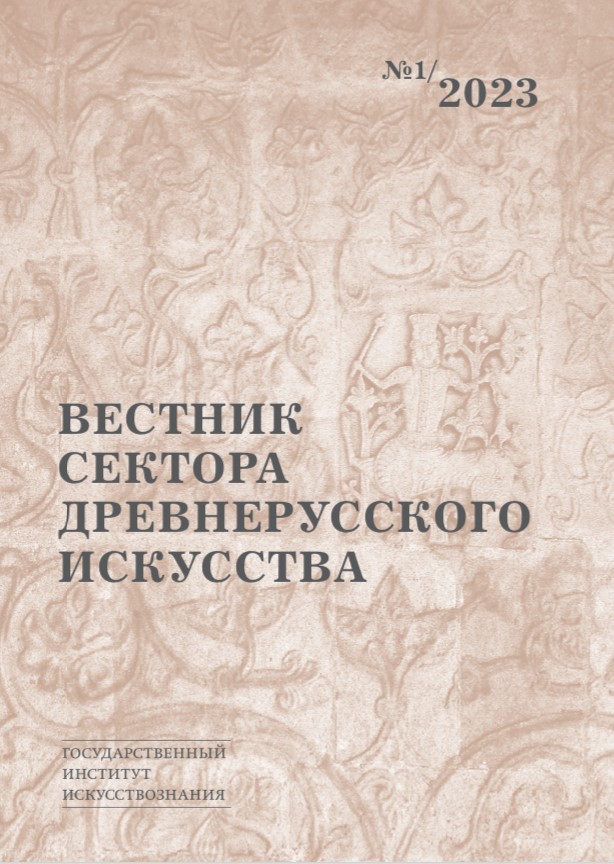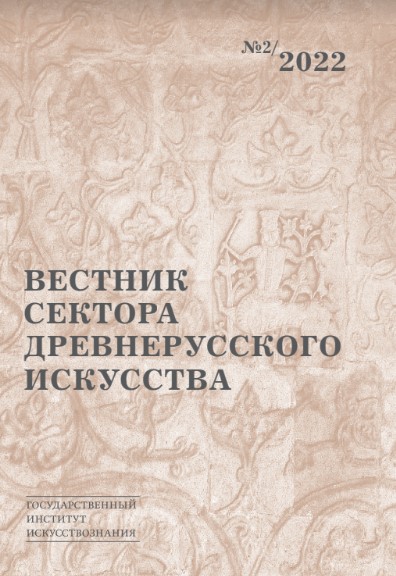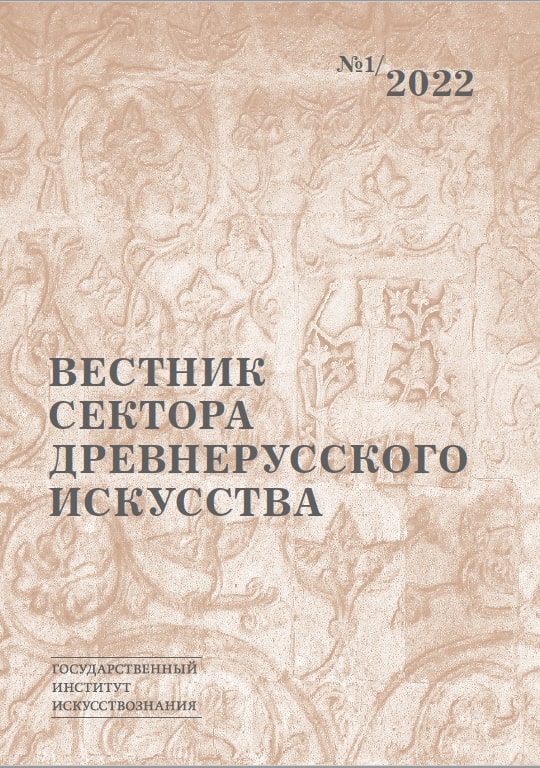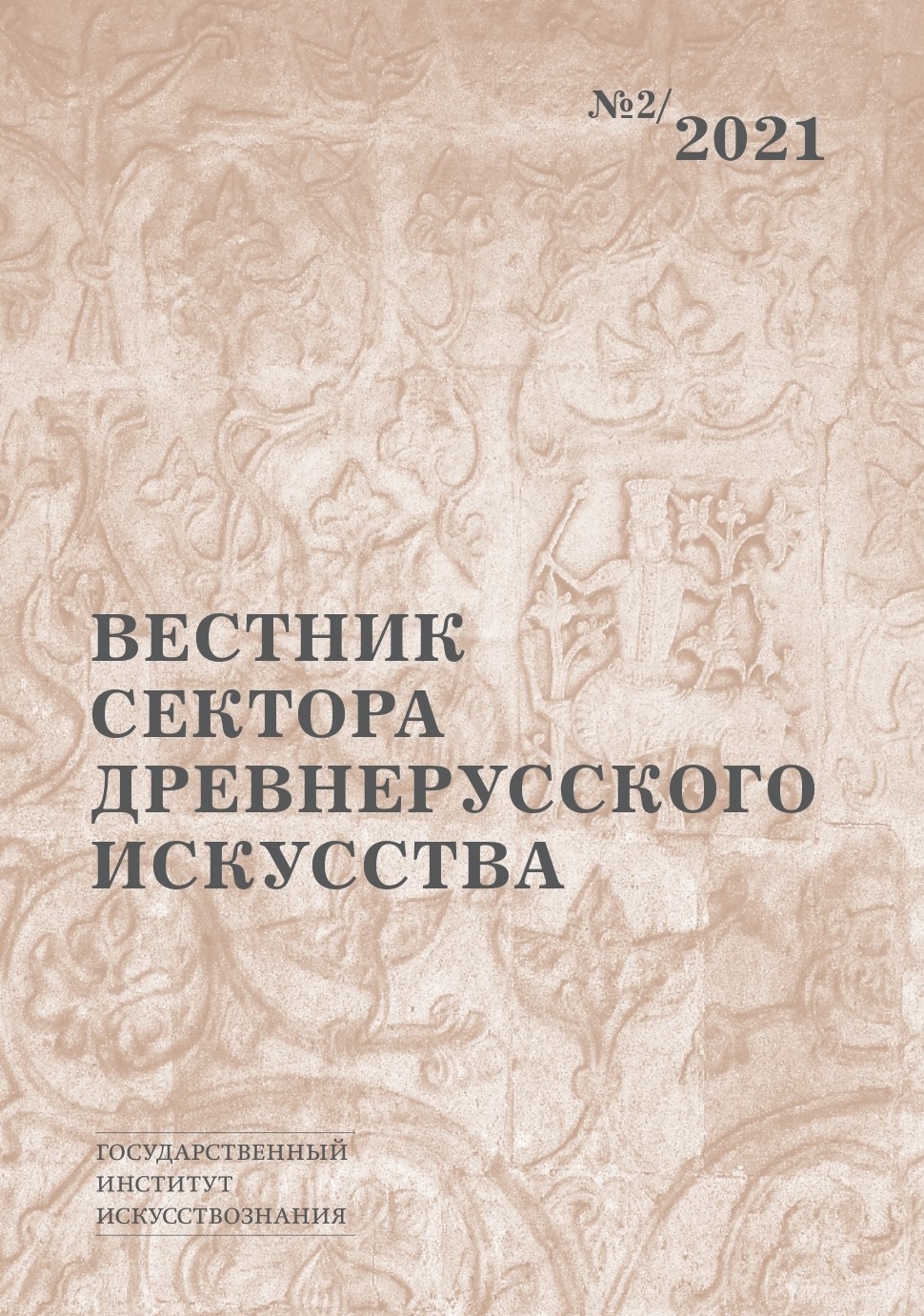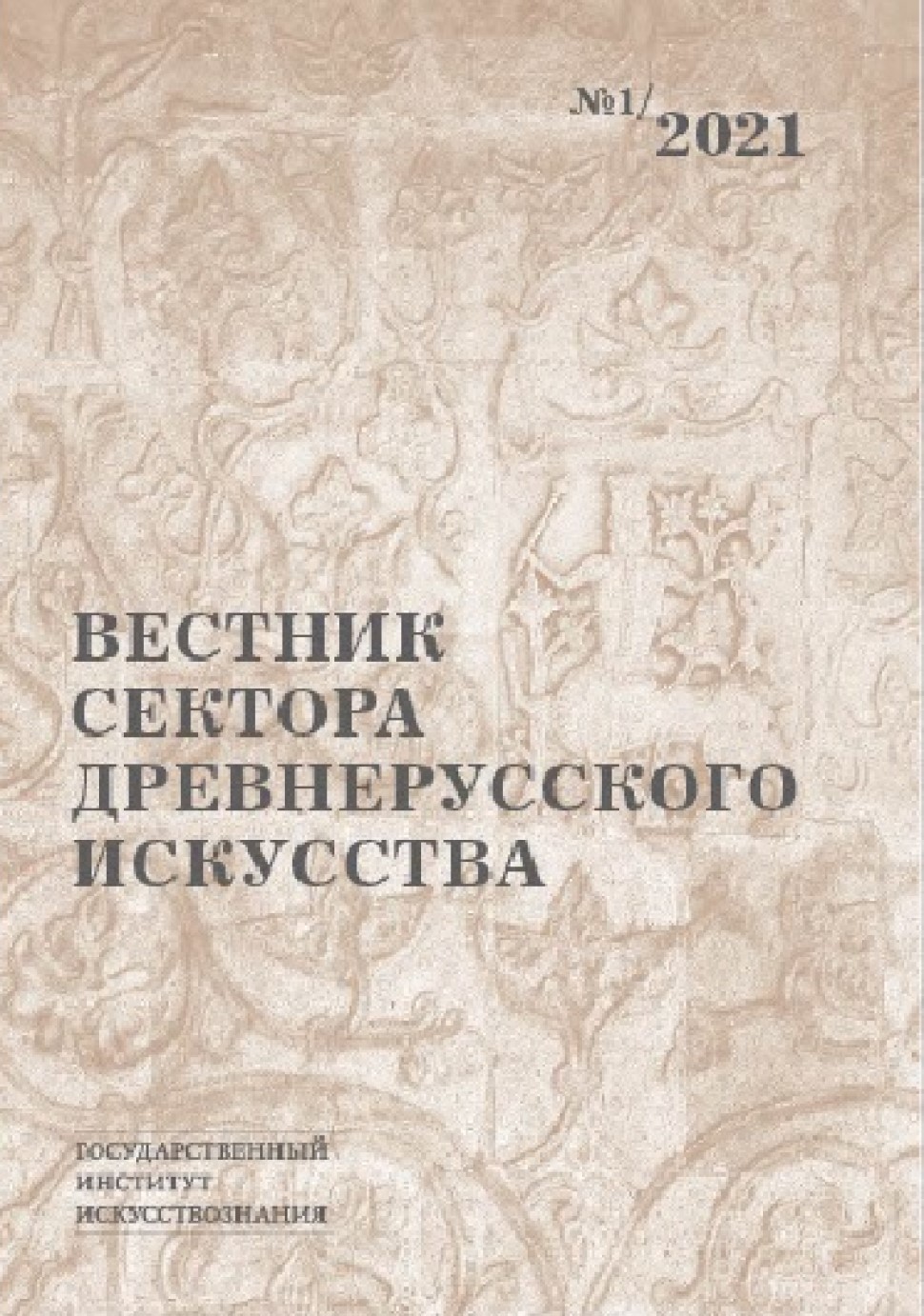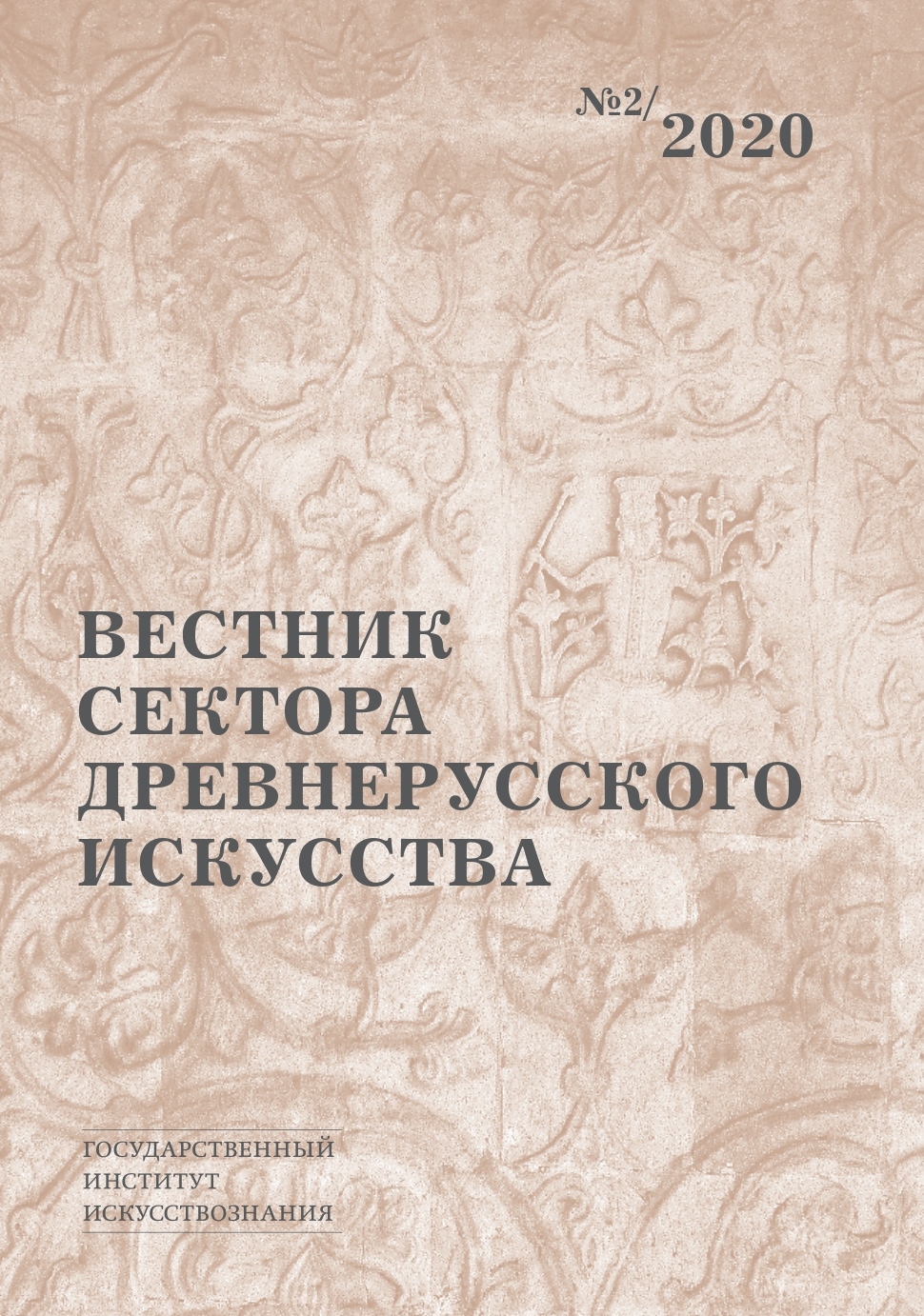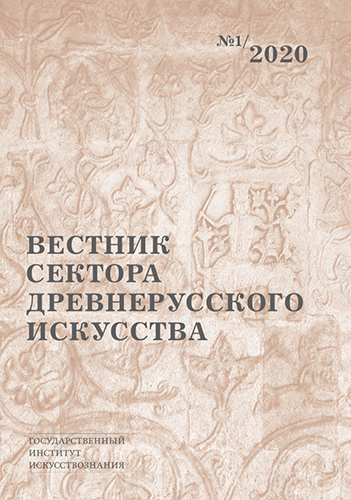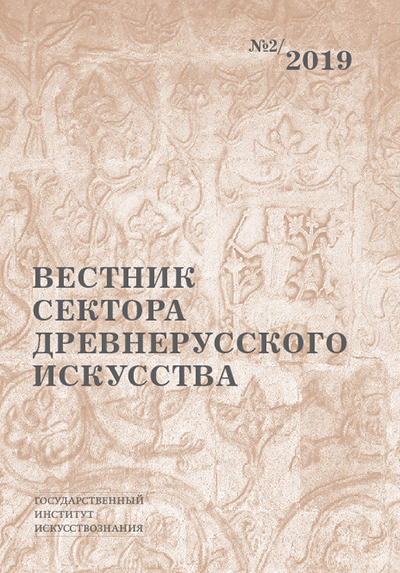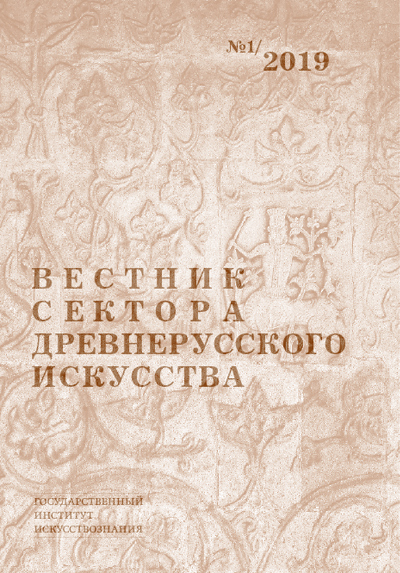2019 № 2
Articles
Abstract
A study of the cadastre books of the Pskov land allows us to determine the origin of a number of old icons of the 14th century, including images of Hodegetria and the Pantokrator (“Eleazarovsky”), which became famous as miracle-working icons (both from the Pskov Museum), as well as “Boris and Gleb” (Tretyakov Gallery), which was included in the decoration of the Nativity of Holy Virgin Cathedral of the Snetogorsky Monastery (1309), decorated in 1313. At the same time, the monumental worship icon of Hodegetria together with the images of the saints in the lower register of the frescoes on the eastern wall of the church, built on the site where the first prior and monks suffered martyrdom at the hands of German knights, created a single group conceived as a memorial pantheon. The composition of Hodegetria, dating back to Byzantine iconography such as the Cypriot image of Our Lady of Arakiotissa (1192), is known in Russia only from Pskov art and starting from the 13th century it appears here very consistently. The unique features of the Snetogory icon, primarily the figures of angels with incense burners on the sides of the Virgin, are explained by the memorial function of the church. The artistic features leave no doubt that the image was created simultaneously with the frescoes of the church in 1313 by the chief master. He represented the leading line of Pskov art, reflecting the spiritual quest of both the extreme asceticism, of which the Snetogorsky monastery became the center in those years, and also the ideals of the urban elite, whose representatives were its main customers and donators.
Keywords
Byzantine and Russian icon painting of the end of 13th — beginning of the 14th century, Pskov, Snetogorsky monastery, census books of the monastery property, artistic style, iconography of the Hodegitria.
Abstract
The article, dedicated to the icon St. Nicholas with Selected Saints on the Margins from the collection of the Tretyakov Gallery, which dates back to late 12th—early 13th cc., offers a comprehensive concept to its theological basis. In spite of its well-known status and numerous publications, so far there has not been a single monographic study on the subject. This study was made possible in 2017 through a wide-ranging technical, technological and other research the Tretyakov gallery undertook while preparing a volume of the Academic Catalog dedicated to the oldest pre-Mongol icons of the collection. A number of important conclusions have been made from a closer analysis of the icon with regard to the Byzantine and ancient Russian artistic tradition in the 12th–13th cc., as well as its juxtaposition to related theological and liturgical texts of the same period. It is likely that the figure of St. Nicholas has its origins in the revered icon from Constantinople (the closest iconographic analogy is the mosaic found in the conch of the southern altar apse of the Daphni Monastery, c. 1100). A copy of the miracle icon could possibly end up in Novgorod during the reign of Prince Mstislav Vladimirovich and later could have been replicated. Through the unusual choice of saints and their placement, as well as the connections between the images in the center and on the margins, the icon provides a sophisticated program. Through this program the icon’s creator sought to show the healing and gracious powers of the Apostolic Church established in Russia and its importance for Christians. It becomes apparent through subtle semantic parallels between St. Nicholas the miracle worker, in the center of the icon, an ideal shepherd held equal to apostles, and the council of sacred doctors, martyrs and miracle workers on the margin (two of them, princes Boris and Gleb, were the first canonized Russian saints).
Keywords
Iconography, Saint Nicholas, selected saints, art of the Byzantine world, Novgorodian painting, liturgical texts, healing miracles.
Abstract
The article studies a number of texts describing artworks of the last great epoch of Serbian medieval art which is linked with the end of the 14th and first decades of the 15th centuries in the state of princes and despots from the Lazarević and Branković dynasties. Art restoration was versatile and encompassed architecture, painting, literature and applied art. The new creative zest was accompanied by written compositions dedicated to churches that had been built at that time or earlier, and which were considered to be the most beautiful works of art. They were written by the most educated people of the time: Patriarch Danilo III, Bishop of Peć Marko, Andonije Rafail, Gregory Tsamblak, Constantine the Philosopher and other writers whose names have remained unknown. Their descriptions of the monasteries are similar to the Byzantine ekphrases, which these writers must have been familiar with. Such descriptions never appear as independent works both in Slavonic and in Serbian literature, but have always been a part of another composition, usually of a religious genre.
Keywords
Serbia, 14th–15th centuries, art, literature, texts about artworks.
Abstract
The article is devoted to the stylistic analysis of a little-known work of Old Russian silversmithing — the casement panagia, which is now stored in the Raifa Monastery of the Republic of Tatarstan. Comparison of artistic features, drawing, plastic and spatial elements, taking into account iconography and a semantic program, make it possible to put the masters of this work on a par with the best artists of their time. Thanks to the work done, the history of Old Russian art receives another example of the Late Paleological era in the artistic culture of Old Russia, the era of Theophanes the Greek and Andrei Rublev (late 14th — first third of the 15th century).
Keywords
Panagia, Holy Trinity, Andrei Rublev, Theophanes the Greek, Byzantine art, the Era of the Paleologs, Old Russian art, toreutics (silverware).
Abstract
The article is devoted to ascertaining the origin, authentication and clarification of the dating of two icons from the sacristy of the Trinity-Sergius Lavra, which is found in a private collection in Switzerland. One of them is the Icon of the Savior the Almighty, dated the second quarter to the middle of the 15th century. Its silver embossed cover preserves the traditions of the capital’s masters of the circle of the Greek Metropolitan Photius. The second, also small “pyadnitsa” icon, Our Lady of the Don, of the second half of the 16th century, may have been created within the walls of the Trinity Lavra of St. Sergius Monastery by a local icon painter. The Don iconography was popular within the walls of the monastery according to the legends about the presence of an icon of a similar iconography in the Battle of Kulikovo in 1380.
Keywords
Old Russian icon painting, private collection in Switzerland, sacristy of the Trinity Lavra of St. Sergius, authentication problems.
Abstract
A block with a floral motif is included in the white-stone masonry of the trefoil on the northern facade of the Church of the Annunciation in Stepanovskoe. An analysis of its iconography showed that it was intended for a white-stone carved decoration of the southern gallery of the Annunciation Cathedral and the Treasury Chamber at the Sovereign’s Court associated with it. Works in the Kremlin can be dated between 1551 and 1564. After their completion, this spolia was used together with other building materials during the construction of the church in the estate of Tsar’s brother-in-law, N. R. Zakharyin-Yuriev. An analysis of the compositional features of this church, its production technology, as well as identification of the spolia, allows its construction to be attributed to the 1560s.
Keywords
Architecture of the era of Ivan the Terrible, Nikita Romanovich Zakharyin-Yuriev, white stone, groin vault, pillarless churches, patrimonial construction.
Smirnova Engelina S.Russian 16th Century Icon of Saint Tryphon as a Warrior
Abstract
Veneration of saint martyr Tryphon in the regions of the Orthodox world was especially prevalent in the lands of the southern Slavs and was most often associated with the image of a young martyr, the patron saint of peasant occupations. Meanwhile, in Russian art, his images are known as a young warrior (the oldest surviving in the Pogodinsky Prologue dates back to the 14th century). The image of St. Tryphon as a warrior is also found in a small icon — the “pyadnitsa” of the 16th century in the Serbian monastery of Hilandar on Mount Athos. Since the icons of this special format were usually miniature replicas of famous large icons, it should be assumed that the Hilandar icon copies the church image of the 16th century (not survived to our time) from the church of St. Tryphon in Naprudny on the territory of modern Moscow. This temple was connected with the royal court. The published Hilandar icon expands the idea of the court Moscow culture of that time.
Keywords
Hilandar Monastery, Russian icon, warrior saints, small “pyadnitsa” icons, Moscow architecture, St. Tryphon Church in Naprudny.
Kliukanova Ol’gaV.Carved Icon of Nicholas the Wonderworker from the Collection of the Russian Museum
Abstract
The purpose of the article is to study the large carved icon of St. Nicholas the Wonderworker from the collection of the Russian Museum. The research uses iconographic and stylistic methods and includes the material data of the monument and the data of restoration studies, carried out in the Russian Museum in 1940–1978. Taking into account the information that the monument originates from Novgorod, it is proposed to consider the icon in the context of the history of the spread and development of sculpture in the Novgorod-Pskov lands in the middle of the 16th century. A comparative analysis is carried out with the sculpture of Nikola from Mozhaisk, 1540, from the collection of the Pskov Museum and the carvings of Paraskeva Pyatnitsa from Novgorod. The suggested hypothesis is that the carved icon of St. Nicholas, now in the Russian Museum, was created in 1540–1542 commissioned by St. Makarius for Novgorod and based on the Pskov sculpture as a model.
Keywords
Russian Museum, history of collections, Old Russian sculpture, Novgorod plastic arts, wood carving.
Abstract
The Resurrection gate (dismantled in the 1930s; restored in 1995) originated as a travel arch in the tower of Kitay-Gorod, built in the 1530s. In 1680, it received a superstructure that significantly changed its architectural appearance. The discovered contract and other information reflecting the process of its reconstruction, as well as traditional for the end of the 17th century practice suggest that the restructuring of 1680 most likely did not affect the pylons of the gate, and possibly the arches connecting it. The architectural and artistic prerequisites of its architectural composition are considered, the direct architectural prototype and analogues are found out. It is shown that the resurrection gate was an architectural and functional prototype of the Triumphal arches of Modern times.
Keywords
The State of Moscow, Kitai-Gorod, the Resurrection Gate, Ancient Russian Architecture, Archaeology, Triumphal Arches.
Abstract
In the 19th — early 20th centuries different crafts were developing in the convents of the Arkhangelsk province. Nuns and novices created icons and paintings, embroidered church fabrics with gold, pearls and beads. These items were sold to worshipers. The stable tradition of needlework and icon painting was formed in the convent of Assumption in Kholmogory, of Holy Trinity in Shenkursk, of Saint John in Sura, of Saint Jove in Ushchelie. The best items were exhibited in Arkhangelsk and St. Petersburg. Women’s handicraft workshops provided for household and church needs of these convents.
Keywords
Icon, icon painter, monastery, church, culture of the Russian North, Arkhangelsk Eparchy, artistic handicraft.
Chronicles
Restoration Chronicles
Lifshits Lev I., Skobtsova Dar’ia A.A Brief Note about a Trip to the Tira Monastery near Tskhinva
Exhibitions
Buzykina Iuliia N.Treasured Icons of the Russian Empire. Trip to the East
Gulmanov Alexei L.The Exhibition Isaac Birev’s Gospel
Conferences
Tsarevskaia Tat’iana Yu.Review of the Conference St. Anthony of Rome and His Time
